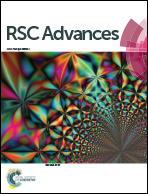Photodegradation performance and recyclability of a porous nitrogen and carbon co-doped TiO2/activated carbon composite prepared by an extremely fast one-step microwave method
Abstract
In recent years, microwave sintering has become a common tool in materials science because of its rapid heating rate and high energy utilization efficiency. In this study, a fast one-step microwave method (3 min) was employed to prepare a porous nitrogen and carbon co-doped TiO2/activated carbon ((C,N)-TiO2/AC) composite bulk material. The samples were characterized by X-ray diffraction (XRD), scanning electron microscopy (SEM), X-ray photoelectron spectroscopy (XPS), photoluminescence (PL) spectroscopy, ultraviolet-visible diffuse reflectance spectroscopy (UV-Vis DRS), and electrical conductivity measurements. Photodegradation and recyclability experiments were also performed. For comparison, a sample was made by physically mixing (C,N)-TiO2 and AC, and was characterized and examined by the same technique. The photodegradation of a methyl orange solution by the porous (C,N)-TiO2/AC bulk revealed its good photocatalytic properties, with 94% photodegradation occurring within 100 min of irradiation following the initial 4 h of adsorption in the dark. The porous (C,N)-TiO2/AC bulk also demonstrated very good recyclability, achieving 94% photodegradation in the 6th recycle. The results show that the composite material can be used in commercial photodegradation processes because of its low cost, simple method of preparation, and good recyclability.


 Please wait while we load your content...
Please wait while we load your content...